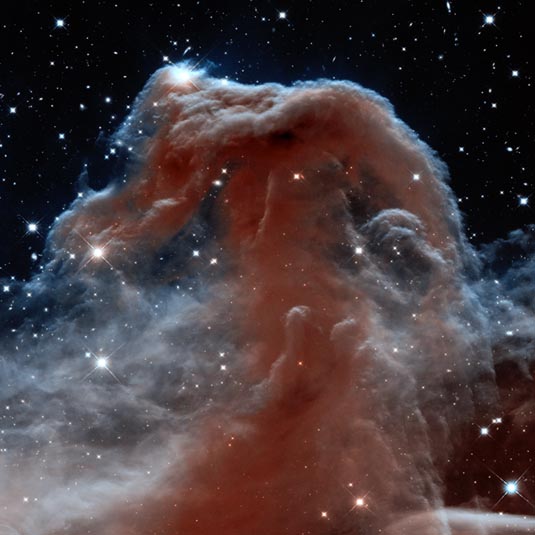
Dark Nebula
RA 05h 40m 59.00s Dec. -02° 27' 30.0"
Orion
1,600 light-years (490 parsecs)
5.75 arcminutes (2.5 light-years or 0.8 parsecs) wide.
WFC3/IR
October 22, 2012 - November 7, 2012
NASA, ESA, and the Hubble Heritage Team (STScI/AURA)
April 18, 2013
Normal: N0202 Closeup: N0112 Infrared: N1312 Related: N0949
ABOUT THIS IMAGE:
Astronomers have used NASA's Hubble Space Telescope to photograph the iconic Horsehead Nebula in a new, infrared light to mark the 23rd anniversary of the famous observatory's launch aboard the space shuttle Discovery on April 24, 1990.
Hubble has been producing ground-breaking science for two decades. During that time, it has benefited from a slew of upgrades from space shuttle missions, including the 2009 addition of a new imaging workhorse, the high-resolution Wide Field Camera 3 that took the new portrait of the Horsehead.
Looking like an apparition rising from whitecaps of interstellar foam, the iconic Horsehead Nebula has graced astronomy books ever since its discovery over a century ago. The nebula is a favorite target for amateur and professional astronomers.
In this new Hubble Space Telescope view, the nebula appears in a new light, as seen in infrared wavelengths. The nebula, shadowy in optical light, appears transparent and ethereal when seen in the infrared, represented here with visible shades. The rich tapestry of the Horsehead Nebula pops out against the backdrop of Milky Way stars and distant galaxies that are easily seen in infrared light.
The Horsehead was photographed in celebration of the 23rd anniversary of the launch of Hubble aboard the space shuttle Discovery. Over its two decades of producing ground-breaking science, Hubble has benefited from a slew of upgrades, including the 2009 addition of a new imaging workhorse: the high-resolution Wide Field Camera 3 that was used to take this portrait of the Horsehead.
The backlit wisps along the Horsehead's upper ridge are being illuminated by Sigma Orionis, a young five-star system just off the top of the Hubble image. A harsh ultraviolet glare from one of these bright stars is slowly evaporating the nebula. Along the nebula's top ridge, two fledgling stars peek out from their now-exposed nurseries.
Gas clouds surrounding the Horsehead have already dissipated, but the tip of the jutting pillar contains a slightly higher density of hydrogen and helium, laced with dust. This casts a shadow that protects material behind it from being stripped away by intense stellar radiation evaporating the hydrogen cloud, and a pillar structure forms. Astronomers estimate that the Horsehead formation has about five million years left before it too disintegrates.
The Horsehead Nebula is part of a much larger complex in the constellation Orion. Known collectively as the Orion Molecular Cloud, it also houses other famous objects such as the Great Orion Nebula (M42), the Flame Nebula, and Barnard's Loop. At about 1,500 light-years away, this complex is one of the nearest and most easily photographed regions in which massive stars are being formed.
Hubble's
pairing of infrared sensitivity and unparalleled resolution offers a tantalizing
hint of what the upcoming James Webb Space Telescope, set for launch in
2018, will be able to do.
Color:
This image is a composite of separate exposures acquired by the WFC3/IR
instruments. Several filters were used to sample various wavelengths.
The color results from assigning different hues (colors) to each monochromatic
(grayscale) image associated with an individual filter. In this case,
the assigned colors are:
F110W (YJ) green
F160W (H) red